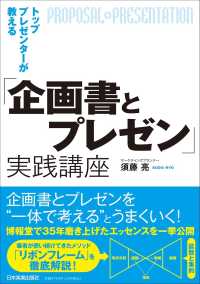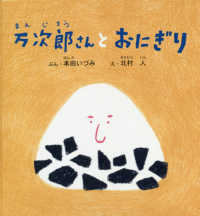- ホーム
- > 洋書
- > 英文書
- > Science / Mathematics
Full Description
Sensory analysis is not new to the food industry, but its application as a basic tool in food product development and quality control has not been given the recognition and acceptance it deserves. This, we believe, is largely due to the lack of understanding about what sensory analysis can offer in product research, development and marketing, and a fear that the discipline is 'too scientific' to be practical. To some extent, sensory scientists have perpetuated this fear with a failure to recognize the constraints of industry in implementing sensory testing procedures. These guidelines are an attempt to redress the balance. Of course, product 'tasting' is carried out in every food company: it may be the morning tasting session by the managing director, competitor comparisons by the marketeers, tasting by a product 'expert' giving a quality opinion, comparison of new recipes from the product development kitchen, or on-line checking during pro duction. Most relevant, though, is that the people respon sible for the tasting session should know why the work is being done, and fully realize that if it is not done well, then the results and conclusions drawn, and their implications, are likely to be misleading. If, through the production of these guidelines, we have influenced some people suffi ciently for them to re-evaluate what they are doing, and why, we believe our efforts have been worthwhile.
Contents
1 What is sensory analysis used for?.- 2 How to use sensory analysis to meet your objective.- 3 What samples are being analysed?.- 4 Who are the right people for sensory analysis?.- 5 Experimental design and data analysis.- 6 Putting sensory analysis into practice.- 7 Reporting and recording.- 8 Case history: Shelf-life studies.- 9 Case history: Product matching.- 10 Case history: Product matching achieved through product mapping.- 11 Case history: Taint investigation.- 12 Case history: Taint prevention.- 13 Case history: Specification and quality control.- Appendix: Some useful tables for sensory tests.- Glossary of terms used in sensory analysis.








